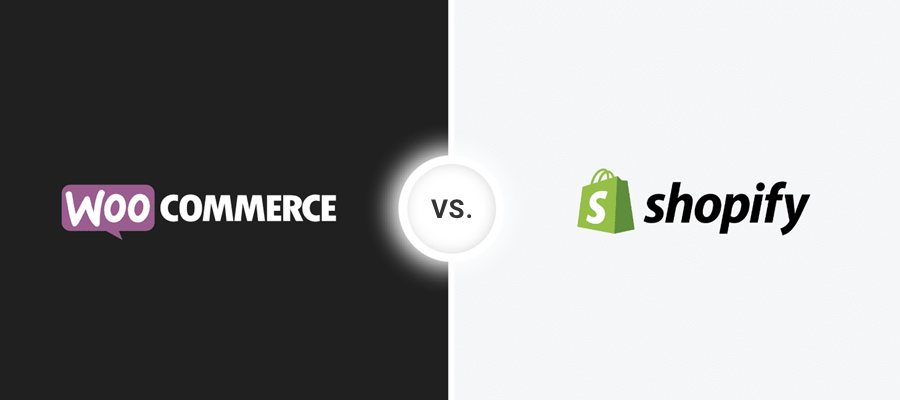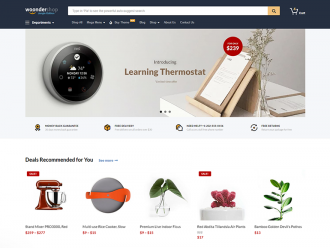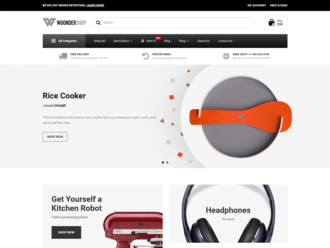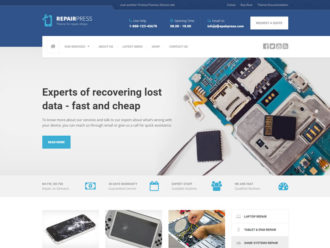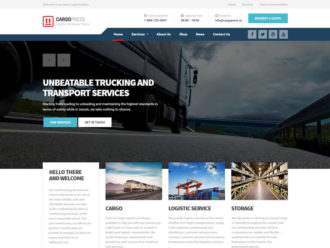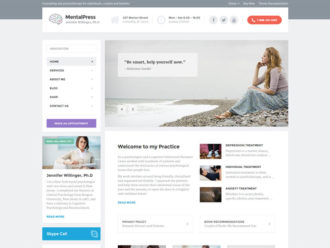The two big names that you’ll come across in the eCommerce platform world are WooCommerce and Shopify. Being the two most popular eCommerce platforms currently on the market, there are a few advantages and disadvantages to choosing one over the other.
But how do you decide which one is right for you?
Honest answer? It all depends on what you want. In this article, we’ll try to give you the best overview we can for both Shopify and WooCommerce so that you have an idea of what each platform has to offer and deciding which one works best for you.
Overview: WooCommerce vs. Shopify
Before we get into the nitty-gritty of what makes WooCommerce and Shopify different from each other, let’s cover the basics and highlight what makes each platform stands out.
What is Shopify?
In a sense, it’s an online tool that lets you build an eCommerce store without having any knowledge of coding.
With Shopify, you don’t a developer or coder if you get stuck as Shopify will help and guide you throughout the process.
Using Shopify, you’re able to sell all sorts of products, including physical items, digital downloads, drop shipped products, and even services. For those with brick-and-mortar shops, you can easily integrate it with Shopify using their Point-Of-Sale devices.
Shopify offers a simple turnkey solution for those who want to set up a store quickly and have it running.
What is WooCommerce
To understand WooCommerce, you first need to know about WordPress. WordPress is an open-source website building platform that’s quite popular on the internet. They practically run ¼ of the websites on the internet, including some big name websites.
However, the focus of WordPress is not to built eCommerce sites specifically. Instead, it’s more of an all-in-one solution for building websites and sharing content. Of course, you can still build an eCommerce store using WordPress, you just need a little held.
That’s where WooCommerce comes in handy. WooCommerce is actually a WordPress plugin that adds a number of eCommerce features to a WordPress website, which includes shopping carts, product pages, inventory management, and more.
The great thing is both WordPress and WooCommerce are free. This should help ease your budget and let you focus on other expenses such as finding the best web hosting for your website.
What You Need To Know About Shopify
You should be familiar with what both services are at this point, so let’s take it a step further and explore more about Shopify.
Shopify Designs
Making a good first impression is important for an eCommerce store. An online store needs to look professional, clean, and easy to navigate. If you have a terrible looking site, then odds are people won’t buy anything from you.
If you want your eCommerce store to succeed, you need to take design seriously.
Thankfully, Shopify offers more than 50 different, professionally designed store themes that you can use. A number of them are free while some will cost you anywhere between $140 – $200.
Since all of their themes are professionally designed, you can easily customize it to make it look and feel the way you want for your shop.
Given that Shopify outsources their theme designs to professional developers, you can be sure that all themes are appropriately updated. The downside is that using these themes, especially the premium ones, can be pricey.
Editing and changing the design options on Shopify is pretty straightforward. You can easily change the colors or styles at any time and also update your site with new items whenever you want. You can even edit sections of your store without taking it offline.
For advanced developers, you can use their specialized “Liquid” language to do more significant changes. This is not necessary but is optional if you want to go make deeper changes.
Shopify Pricing
Since Shopify is a Software As A Service (SaaS), they bundled all of their services together in several pricing tiers. Depending on which tier you sign up, you will have access to different features and options.
This can be good or bad, depending on your needs. On one hand, you get all the things you need right out of the box, on the other hand, you’re locked into Shopify’s pricing tiers which can be restrictive.
While their most popular option is the Basic Shopify package, they do offer a number of options that you can opt for:
- Lite ($9 monthly)
- Basic Shopify ($29 monthly)
- Shopify ($79 monthly)
- Advanced Shopify ($299 monthly)
In addition to the monthly fees, you also have to pay a transaction fee whenever you sell something. Shopify will take a small cut of every transaction, and if you’re using a payment gateway, such as PayPal or Stripe, there will be additional transaction fees for them.
Shopify Features
Shopify aims to be the turnkey product for people who want to quickly and easily build an eCommerce store. Because of that, they include a wide variety of features that you can use.
Some of them include:
- Unlimited products
- Automatic fraud analysis
- Payments via credit cards
- Support for multiple languages
- Unlimited file storage
- Drop shipping capabilities
- Codes for discounts
- Optimization for mobile users
- A fully featured mobile app
- Integration with social media
- Unlimited traffic for your online store
- Conversion optimization best-practices
Shopify Ease of Use
One of the big focuses for Shopify is to make their platform as easy as possible for users to get started with. They’ve intentionally designed everything to be quick and easy.
To get started with Shopify, all you need to do is go to Shopify.com, complete the signup wizard process, and then you’re done.
Once you’ve done that, you can start selling your products online. It’s that simple!
Their dashboard design also makes it easy for you to keep track of your store’s performance and to highlight any issues that you need to be aware of. It’s also super easy to adjust settings such as shipping, taxes, refunds, new orders, and more.
For those who are intimidated with technology, Shopify tries to make everything as easy as possible for you.
What You Need To Know About WooCommerce
So now that you know more about Shopify, it’s time to take a look at WooCommerce. At first glance, they might offer the same thing but WooCommerce does have one big advantage: control.
Shopify stores are built on Shopify’s platform, which means you’re limited to what they offer, such as themes or selling options. WooCommerce, on the other hand, allows for almost unlimited options since you’re using the WordPress platform, which comes with thousands of themes and plugins.
To take it a step further, WordPress and WooCommerce are essentially tools that you can use to build your own website from scratch, which gives you more control, more options, and more ability to customize your website and its design.
WooCommerce Design
As we’ve mentioned, WooCommerce is designed to work with WordPress themes. This gives you nearly unlimited options when it comes to design options.
Already have a WordPress site and a design you like? WooCommerce will work with it. Just getting started? Just pick a WooCommerce theme such as WoonderShop and use WooCommerce to add eCommerce functionality to it.
If you have trouble selecting themes, there are a number of themes that have been built specifically for WooCommerce. The Storefront theme is a great choice if you just want a simple yet beautiful design for your online store.
While Shopify does have an impressive range of themes, WooCommerce has more variety in both template design and website features. Since WooCommerce can integrate with any WordPress plugin, you have a nearly infinite selection of plugins to work with.
When it comes to design, WooCommerce has more options and flexibility. However, that also means you’ll need to put more time and effort into designing your store. If you don’t want to deal with all that work, then Shopify might be a better choice.
WooCommerce Pricing
The cost for using WooCommerce and WordPress is ZERO. Since both are free to use, you won’t have to pay a single dime to get started.
However, you will need to purchase a number of things beforehand, such as a web host, domain name, themes (if you chose a premium theme), and any premium plugins that you want to use. Also, you’ll need to factor in transaction fees from WooCommerce payment gateways, which only comes into effect when you make a sale.
At first glance, WooCommerce might seem the cheaper alternative. It’s only when you start purchasing premium themes and plugins that you cost will go up. Conversely, you could be paying the same amount on Shopify, depending on the plan you choose.
WooCommerce Features
Similar to Shopify, WooCommerce offers all the features that you would need to start an eCommerce store. While they might necessarily have the exact features that Shopify provides right out of the box, you can still find a plugin for whatever feature you might want.
Just to give you an idea, here are the features that you can get with WooCommerce:
- Hundreds of choices for plugins
- Ability to work with WordPress
- Built-in payments via PayPal and Stripe
- Ability to adjust shipping rates and taxes
- Ability to control all aspects of your website and its data
- Facebook integration (Facebook ads, Facebook store extensions)
- Unlimited products and categories
- Optimized for mobile users
- Complete control of inventory
WooCommerce Ease of Use
Working WooCommerce is just as easy as using Shopify. You just need to get through the initial steps of setting up your WordPress website.
While setting up a WordPress is not necessarily difficult, it can take some time and will involve some technical details. You might have some trouble with the initial setup if you’re not technologically savvy, but it shouldn’t be too difficult nonetheless.
To sum up the steps for using WooCommerce, it basically goes as follows:
- Purchase a domain name
- Sign up for a web host
- Install WordPress
- Install WooCommerce plugin
- Install any additional plugins if needed
Now, if the steps intimidate you, you can opt for hosting companies that specialized in setting up WordPress websites. Some companies offer 1-click WordPress and WooCommerce installations, which means you can have your store ready with minimal technical work.
When your WooCommerce platform is up and running, you can then go through its setup wizard to set up things such as currency settings, shipping options, payment gateways, and more.
Which One is Right For You?
To be honest, the choice between Shopify and WooCommerce ultimately lies on you and what you want out of your eCommerce store.
To break it down for you:
Go For Shopify If…
If you want a simple eCommerce solution, then Shopify is your best bet. Shopify is designed in a way that anyone with the most basic knowledge of computers and internet skills, to create a powerful and fully operational online store right away.
If simplicity and ease of use are your main concerns, Shopify has that in spades. Their setup is easy and quick and they have a single dashboard that gives you an overview of all the information you need.
Shopify is for those who…
- Don’t have a website and wants to create an eCommerce store fast with minimal effort
- Don’t mind paying a fee for all features, even the ones you might not need
- Not familiar with the technological side of an eCommerce store and just want something that works
- Don’t want to deal with the hassle of setting up a WordPress website and pay other to set it up for you
Go For WooCommerce If…
WooCommerce is a great choice if you love to tinker with your eCommerce store and would like to have access to thousands of themes and plugins that can really make your website stand out.
In terms of functionality, WooCommerce can do everything that Shopify can, such as adding coupons, handle shipping, adjust tax rates, and more. You also have significantly more options and control when it comes customizing your online store with WooCommerce.
WooCommerce is for those who…
- Want to have full control of their online store
- Want to enhance their eCommerce store using a wide variety of theme and plugins
- Are able to handle some technical work upfront to get your online store running
- Prefer to do everything on their own
- Have a smaller budget
- Already have a WordPress website and wants to add an online store to it
- Already have a WordPress website and don’t want the additional cost of using Shopify
Bottom Line
Both WooCommerce and Shopify are great choices for starting an eCommerce store and whichever you choose, you’ll end up with a fully-functional online store that can help make money.
Rather than figuring which one works for you, you should ask yourself “what are you waiting for?”
Go create your eCommerce empire and start making money!
